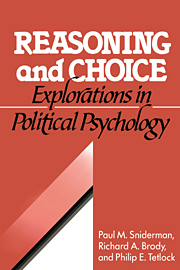Book contents
- Frontmatter
- Contents
- List of tables and figures
- Preface
- 1 Introduction: major themes
- 2 The role of heuristics in political reasoning: a theory sketch
- 3 Values under pressure: AIDS and civil liberties
- 4 The principle–policy puzzle: the paradox of American racial attitudes
- 5 Reasoning chains
- 6 The likability heuristic
- 7 Democratic values and mass publics
- 8 Ideological reasoning
- 9 Information and electoral choice
- 10 Stability and change in party identification: presidential to off-years
- 11 The American dilemma: the role of law as a persuasive symbol
- 12 Ideology and issue persuasibility: dynamics of racial policy attitudes
- 13 The new racism and the American ethos
- 14 Retrospect and prospect
- Notes
- Bibliography
- Subject index
- Author index
2 - The role of heuristics in political reasoning: a theory sketch
Published online by Cambridge University Press: 05 May 2010
- Frontmatter
- Contents
- List of tables and figures
- Preface
- 1 Introduction: major themes
- 2 The role of heuristics in political reasoning: a theory sketch
- 3 Values under pressure: AIDS and civil liberties
- 4 The principle–policy puzzle: the paradox of American racial attitudes
- 5 Reasoning chains
- 6 The likability heuristic
- 7 Democratic values and mass publics
- 8 Ideological reasoning
- 9 Information and electoral choice
- 10 Stability and change in party identification: presidential to off-years
- 11 The American dilemma: the role of law as a persuasive symbol
- 12 Ideology and issue persuasibility: dynamics of racial policy attitudes
- 13 The new racism and the American ethos
- 14 Retrospect and prospect
- Notes
- Bibliography
- Subject index
- Author index
Summary
Chapter 2 sets out a theory sketch, laying out some of the principal arguments that under-pin our research program. The term theory sketch we employ to give fair warning: Our ideas are still in the process of development.
It is commonplace to observe that empirical studies are undertaken to test theories – commonplace and quite wrong so far as political analysis is concerned. It puts the cart before the horse: It supposes that we have already been blessed with an assortment of high-grade theories, and our task is only to decide which of them is correct; it would be too kind to characterize this supposition as an exaggeration. The task is precisely to develop a set of arguments that deserve to be characterized as a theory.
Following Popper, we believe the right way to do this is any way that works. In our case, we have focused continuously on a puzzle: How can citizens figure out what they favor and oppose politically given how little they know about politics? But our focus is not in the abstract: Always we have attacked our puzzle in the context of a specific data set. […]
- Type
- Chapter
- Information
- Reasoning and ChoiceExplorations in Political Psychology, pp. 14 - 30Publisher: Cambridge University PressPrint publication year: 1991
- 13
- Cited by



